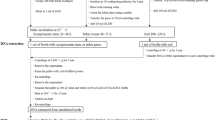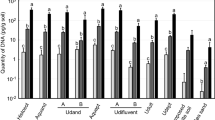Abstract
The aim of this study was to develop a PCR-based rapid method to detect Bacillus cereus group cells from paper and cardboard. Primers targeting the 16S rDNA and real-time PCR with SYBR green I detection were used in order to be able to also quantify the target. Both autoclaved cardboard samples spiked with B. cereus vegetative cells or spores and naturally contaminated paper and cardboard samples were studied. Results were compared with culturing verified by commercial (API) tests. Several different methods were tested for DNA isolation from the paper and cardboard samples. Two commercial kits intended for soils, the UltraClean soil DNA kit and the FastDNA spin kit for soil, gave the most reproducible results. In spiked samples, the average yield was 50% of added vegetative cells, but spore yield was only about 10%. PCR results from adding vegetative cells correlated with added colony-forming unit (cfu) values (r=0.93, P <0.001) in the range 100–10,000 cfu g−1. Three out of nine studied paper and cardboard samples contained B. cereus group bacteria, based both on culturing and real-time PCR. The numbers were 102–103 bacteria g−1; and PCR gave somewhat higher results than culturing. Thus, real-time PCR can be used as a rapid semi-quantitative method to screen paper and cardboard samples for contamination with B. cereus group bacteria.


Similar content being viewed by others
References
Amodio-Cocchieri R, Cirillo T, Villani F, Moschetti G (1998) The occurrence of Bacillus cereus in fast foods. Int J Food Sci Nutr 49:303–308
Andersson A, Rönner U, Granum PE (1995) What problems does the food industry have with the spore-forming pathogens Bacillus cereus and Clostridium perfringens? Int J Food Microbiol 28:145–155
Andersson A, Granum PE, Rönner U (1998) The adhesion of Bacillus cereus spores to epithelial cells might be an additional virulence mechanism. Int J Food Microbiol 39:93–99
Andersson A, Svensson B, Christiansson A, Rönner U (1999) Comparison between automatic ribotyping and random amplified polymorphic DNA analysis of Bacillus cereus isolates from the dairy industry. Int J Food Microbiol 47:147–151
Apajalahti JHA, Särkilahti LK, Mäki BRE, Heikkinen JP, Nurminen PH, Holben WE (1998) Effective recovery of bacterial DNA and percent-guanine-plus-cytosine-based analysis of community structure in the gastrointestinal tract of broiler chickens. Appl Environ Microbiol 64:4084–4088
Asano S-I, Nukumizu Y, Bando H, Iizuka T, Yamamoto T (1997) Cloning of novel enterotoxin genes from Bacillus cereus and Bacillus thuringiensis. Appl Environ Microbiol 63:1054–1057
Bach H-J, Errampalli D, Leung KT, Lee H, Hartmann A, Trevors JT, Munch JC (1999) Specific detection of the gene for the extracellular neutral protease of Bacillus cereus by PCR and blot hybridization. Appl Environ Microbiol 65:3226–3228
Beattie SH, Williams AG (1999) Detection of toxigenic strains of Bacillus cereus and other Bacillus spp with an improved cytotoxicity assay. Lett Appl Microbiol 28:221–225
Bej AK, Mahbubani MH, Dicesare JL, Atlas RM (1991) Polymerase chain reaction–gene probe detection of microorganisms by using filter-concentrated samples. Appl Environ Microbiol 57:3529–3534
Belgrader P, Hansford D, Kovacs GTA, Venkateswaran K, Mariella R Jr, Milanovich F, Nasarabadi S, Okuzumi M, Pourahmadi F, Northup MA (1999) A minisonicator to rapidly disrupt bacterial spores for DNA analysis. Anal Chem 71:4232–4236
Blake MR, Weimer BC (1997) Immunomagnetic detection of Bacillus stearothermophilus spores in food and environmental samples. Appl Environ Microbiol 63:1643–1646
Brauns LA, Hudson MC, Oliver JD (1991) Use of the polymerase chain reaction in detection of culturable and non-culturable Vibrio vulnificus cells. Appl Environ Microbiol 57:2651–2655
Carlson CR, Johansen T, Kolstø A-B (1996) The chromosome map of Bacillus thuringiensis subsp. canadensis HD224 is highly similar to that of the Bacillus cereus type strain ATCC 14579. FEMS Microbiol Lett 141:163–167
Damgaard PH, Larsen HD, Hansen BW, Bresciani J, Jorgensen K (1996a) Enterotoxin-producing strains of Bacillus thuringiensis isolated from food. Lett Appl Microbiol 23:146–150
Damgaard PH, Jacobsen CS, Sørensen J (1996b) Development and application of a primer set for specific detection of Bacillus thuringiensis and Bacillus cereus in soil using magnetic capture hybridization and PCR amplification. System Appl Microbiol 19:436–441
De Medici D, Croci L, Delibato E, Di Pasquale S, Filetici E, Toti L (2003) Evaluation of DNA extraction methods for use in combination with SYBR Green I real-time PCR to detect Salmonella enterica serotype enteritidis in poultry. Appl Environ Microbiol 69:3456–3461
Fang JT, Chen C-Y, Kuo W-Y (1999) Microbiological quality and incidence of Staphylococcus aureus and Bacillus cereus in vegetarian food products. Food Microbiol 16:385–391
Francis KP, Mayr R, Stetten F von, Stewart GSAB, Scherer S (1998) Discrimination of psychrotropic and mesophilic strains of the Bacillus cereus group by PCR targeting of major cold shock protein genes. Appl Environ Microbiol 64:3525–3529
Goto K, Omura T, Hara Y, Sadaie Y (2000) Application of the partial 16S rDNA sequence as an index for rapid identification of species in the genus Bacillus. J Gen Appl Microbiol 46:1–8
Granum PE, Lund T (1997) Bacillus cereus and its food poisoning toxins. FEMS Microbiol Lett 157:223–228
Hansen BM, Hendriksen NB (2001) Detection of enterotoxic Bacillus cereus and Bacillus thuringiensis strains by PCR analysis. Appl Environ Microbiol 67:185–189
Hansen BM, Leser TD, Hendriksen NB (2001) Polymerase chain reaction assay for the detection of Bacillus cereus group cells. FEMS Microbiol Lett 202:209–213
Hein I, Lehner A, Rieck P, Klein K, Brandl E, Wagner M (2001) Comparison of different approaches to quantify Staphylococcus aureus cells by real-time quantitative PCR and application of this technique for examination of cheese. Appl Environ Microbiol 67:3122–3126
Herman LMF, De Block JHGE, Waes GMAVJ (1995) A direct PCR detection method for Clostridium tyrobutyricum spores in up to 100 milliliters of raw milk. Appl Environ Microbiol 61:4141–4146
Hsieh YM, Sheu SJ, Chen YL, Tsen HY (1999) Enterotoxigenic profiles and polymerase chain reaction detection of Bacillus cereus group cells and B. cereus strains from foods and food-borne outbreaks. J Appl Microbiol 87:481–490
Jackson SG, Goodbrand RB, Ahmed R, Kasatiya S (1995) Bacillus cereus and Bacillus thuringiensis isolated in a gastroenteritis outbreak investigation. Lett Appl Microbiol 21:103–105
Johansen T, Carlson CR, Kolstø A-B (1996) Variable numbers of rRNA gene operons in Bacillus cereus strains. FEMS Microbiol Lett 136:325–328
Johns M, Harrington L, Titball RW, Leslie DL (1994) Improved methods for the detection of Bacillus anthracis spores by the polymerase chain reaction. Lett Appl Microbiol 18:236–238
Jones DM, Sutcliffe EM, Curry A (1991) Recovery of viable but non-culturable Campylobacter jejuni. J Gen Microbiol 137:2477–2482
Koivula T, Vanne L, Haikara A, Raaska L (2004) PCR-based method for the detection of fungi in corrugating paper. J Ind Microbiol Biotechnol (submitted)
Leuschner RGK, Lillford PJ (2003) Thermal properties of bacterial spores and biopolymers. Int J Food Microbiol 80:131–143
Mäntynen V, Lindström K (1998) A rapid PCR-based DNA test for enterotoxic Bacillus cereus. Appl Environ Microbiol 64:1634–1639
Nogva HK, Rudi K, Naterstad K, Holck A, Lillehaug D (2000) Application of 5′-nuclease PCR for quantitative detection of Listeria monocytogenes in pure cultures, water, skim milk, and unpasteurized whole milk. Appl Environ Microbiol 66:4266–4271
Pirttijärvi TSM, Graeffe TH, Salkinoja-Salonen MS (1996) Bacterial contaminants in liquid packaging boards: assessment of potential for food spoilage. J Appl Bacteriol 81:445–458
Prüss BM, Dietrich R, Nibler B, Märtlbauer E, Scherer S (1999) The hemolytic enterotoxin HBL is broadly distributed among species of the Bacillus cereus group. Appl Environ Microbiol 65:5436–5442
Rosenkvist H, Hansen Å (1995) Contamination profiles and characterisation of Bacillus species in wheat bread and raw materials for bread production. Int J Food Microbiol 26:353–363
Rusul G, Yaacob NH (1995) Prevalence of Bacillus cereus in selected foods and detection of enterotoxin using TECRA-VIA and BCET-RPLA. Int J Food Microbiol 25:131–139
Schaeffer AB, Fulton M (1933) A simplified method of staining endospores. Science 77:194
Suihko M-L (1999) VTT culture collection. Catalogue of strains, 4th edn. (VTT Research Notes) Libella painopalvelu Oy, Espoo
Suihko M-L, Stackebrandt E (2003) Identification of aerobic mesophilic bacilli isolated from board and paper products containing recycled fibres. J Appl Microbiol 94:25–34
Suominen I, Suihko M-L, Salkinoja-Salonen M (1997) Microscopic study of migration of microbes in food-packaging paper and board. J Ind Microbiol Biotechnol 19:104–113
Te Giffel MC, Beumer RR, Granum PE, Rombouts FM (1997) Isolation and characterisation of Bacillus cereus from pasteurised milk in household refrigerators in the Netherlands. Int J Food Microbiol 34:307–318
Vaid A, Bishop AH (1998) The destruction by microwave radiation of bacterial endospores and amplification of the released DNA. J Appl Microbiol 85:115–122
Väisänen OM, Mentu J, Salkinoja-Salonen MS (1991) Bacteria in food packaging paper and board. J Appl Bacteriol 71:130–133
Acknowledgements
We are grateful to Päivi Lepistö for excellent laboratory work and to the paper mills for providing the samples. This work was partly supported the by National Technology Agency of Finland (TEKES) and the Finnish food and paper industries.
Author information
Authors and Affiliations
Corresponding author
Rights and permissions
About this article
Cite this article
Priha, O., Hallamaa, K., Saarela, M. et al. Detection of Bacillus cereus group bacteria from cardboard and paper with real-time PCR. J IND MICROBIOL BIOTECHNOL 31, 161–169 (2004). https://doi.org/10.1007/s10295-004-0125-x
Received:
Accepted:
Published:
Issue Date:
DOI: https://doi.org/10.1007/s10295-004-0125-x




